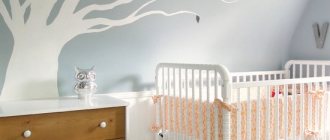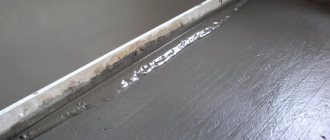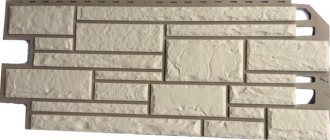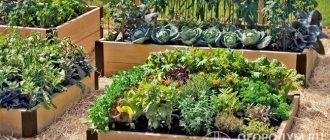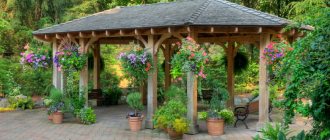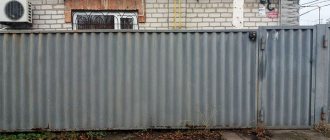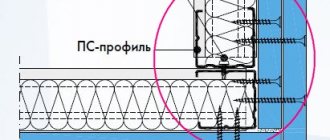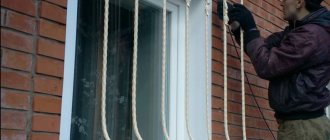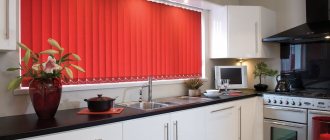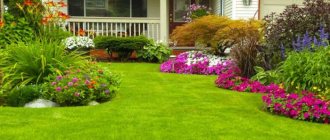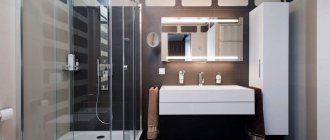Fences for beds - universal purpose
Looking at photos of garden bed fencing, you can see a variety of materials used to build walls around crops.
This is very expressive, but the real uniqueness of thematic designs lies in the following properties:
- Do not allow the soil to spread beyond a certain area after precipitation;
- They prevent the weeds that are outside from growing deeper into the beds, and also contribute to the rapid collection of weeds inside the crop zone;
- They make it easy to install arcs to cover the beds with greenhouse film;
- They protect perennial crops in winter and, thereby, relieve the gardener from spring cultivation;
- They retain heat in the soil if the latter protrudes above the level of the main soil and has a warm organic layer underneath.
If you make fences of different heights, they will fill the landscape with shape by default. And this is not to mention the rational zoning of the site.
On a note. For the winter, inside the sides, if nothing grows there, you can “settle” a bunch of leaves and other waste to create compost. Plants and seeds can be planted in such a base without any fertilizing.
Concrete
Concrete fencing will provide long-lasting protection against erosion. Most often, such fences are used on slopes or to create original terraces.
The material is environmentally friendly, but not exactly cheap. It will require additional effort to form the fence, and will look rather gloomy. The last drawback can be eliminated by placing the original mosaic or using colored material.
Fencing for garden beds - what types are there?
Gardeners and gardeners are captivated by the fact that borders for garden beds can be made from any building material and more.
The main thing is that there is enough of it. Then it will be possible to make many thematic boards of different heights, shapes and areas.
Regarding the choice of material, the target audience prefers:
- Wood;
- Vine;
- Plastic bottles;
- Slate;
- Decorative rock;
- Brick;
- Metal;
- Car tires.
The above diversity already awakens inspiration for creative exploits. But you need to choose consumables wisely. Therefore, let's look at the advantages and disadvantages of each of them.
How to make borders for garden beds from different materials
When the question arises of how to fence the beds, many immediately go in search of available material. Such borders can really be built from anything. An important condition is that they must withstand the pressure of wet soil. You also need to take into account that the width of the beds in the garden should be at least half a meter from the inner edge of the border.
Plastic and metal structures
Do-it-yourself fences for garden beds should look aesthetically pleasing. This will create a certain emphasis on the landscape of the site. Therefore, the organization of these structures should be approached carefully. For example, plastic is a smart modern solution. This material is absolutely harmless, it is not spoiled by pests, and it is considered budget-friendly. It should be chosen in light shades, since this color is practically not warmed up by the sun's rays.
The plastic structure can become deformed due to precipitation. Needs additional protection PHOTO: samara-ogorod.ru
They try to divide long options into sections PHOTO: krrot.net
Metal structures are convenient, but not suitable for well-lit and dry areas. The material heats up quickly, and the plant root system is susceptible to serious overheating. Over time, rust and corrosion appear. This negatively affects the soil composition.
Related article:
Beds made of plastic boards. What are their advantages, examples of creative solutions, average prices, consumer reviews, how to properly assemble a bed from panels with your own hands. Read about this and much more in our review.
Interesting beds made from boards with your own hands: photos of original specimens
Wooden borders for beds are a good and harmless option. A variety of ideas can be used for manufacturing. Such frames are prepared by twisting them into frames using self-tapping screws. We bring to your attention photos of unusual options for making a bed from boards with your own hands.
The decoration emphasizes the purpose of the site PHOTO: yandex.kz
A good option for low-growing berries PHOTO: krrot.net
It is convenient to grow perennial flowers in such structures PHOTO: yandex.com.tr
Unusual garden bed with fencing PHOTO: allremont59.ru
In the future, it is important to know how to treat boards for beds so that they do not interfere with plant growth and are not affected by moisture.
Related article:
Do-it-yourself garden beds are not like everyone else’s. Interesting ideas come to mind for many summer residents and owners of private houses. In the article we will look at original photographic examples and several instructions for creating such beauty.
How to make slate beds with your own hands: photo examples
Surely there are small fragments of slate in every home. They make excellent cheap fencing for vegetable beds. If you also paint them, they will stand out against the general background of the garden.
Long narrow beds are convenient for harvesting PHOTO: 7dach.ru
Decorating a vegetable garden in small fragments with plantings PHOTO: paint-facades.rf
Frame of beds made of smooth slate in a metal frame PHOTO: koffkindom.ru
Brick and concrete beds
Beautiful raised beds can be made from a variety of material options. Concrete and brick are considered the most acceptable. They are much easier to work with and do not require special care. Often such structures are used for planting decorations.
The photo shows the decorative finishing of the brickwork frame PHOTO: roomester.ru
Concrete structures are durable, but they are not convenient for transportation PHOTO: roomester.ru
On a note! Garden plants planted in specially designated fenced areas can be surrounded by lawn grass. This is a completely suitable option for creating paths between the rows.
Making garden beds at the dacha with your own hands: photos of finished models
A beautifully designed vegetable garden with high crop yields is entirely the merit of the owner. The more interesting and correct the beds are created, the better the plants feel. Along with the benefits for them, it is necessary to think about the design of the site itself. We bring to your attention several ideas in photos.
Design of sun-shaped beds PHOTO: dizainlandshafta.ru
Set up areas with crops in a checkerboard pattern PHOTO: doma.life
Design option with pest protection PHOTO: yandex.kz
A small dacha town with a wooden frame PHOTO: yandex.kz
Wood sides
Of course, there is always enough wood. Even if there is no planting or forest nearby, there will always be worn out and broken wooden products.
Some of them are made of chipboard and MDF. But does it really matter when their profile is buried in the ground?
Decomposition, if it occurs, will occur within several years. As a result, the advantages of fencing for beds made of wood are obvious:
Ground cover roses: photos, best varieties, planting features, cultivation and recommendationsSolar garden lamps: overview of all types, operating principle, maintenance, design + selection instructions
- A DIY mailbox is a beautiful decoration and a useful addition to a suburban area
- Availability;
- Stability (strength);
- Suitability for mechanical and chemical processing;
- Air permeability (good for the root system);
- Compliance with the landscape.
Wooden walls also have a disadvantage - they are susceptible to rot and insects. Therefore, before fencing the beds with wood, it is recommended to soak the latter with an antiseptic.
On a note. Conifers contain resins, making them resistant to fungi and rot. Their property is very suitable for creating walls around crops.
Requirements for garden fences
To fence plots, do not choose materials that are very hot in the sun, otherwise the earth will dry out. Decide what you will grow in the garden beds. For flowers, choose more attractive, original fences, for vegetables - focusing on the characteristics of their cultivation (some need high fences, others need low ones). In addition, garden fences should be:
- Durable - to withstand the pressure of the earth, deformation does not occur in spring and autumn, when the soil gets wet.
- Resistant to mechanical damage - the material should not crack when struck by working tools.
- Durable – optimal service life is 5–10 years.
- Easy to assemble - it should be possible to dismantle and move the structures.
- Eco-friendly - without releasing toxins, otherwise harmful substances will penetrate into the soil, roots, greens, fruits. Especially check the safety of polymer materials, which may contain plasticizers that are toxic at elevated temperatures.
- Economical - the cheapest materials - boards, old bricks, plastic containers.
Plastic fence
The dimensions of the beds must meet the following requirements:
- Height with fertile soil – from 15 cm.
- If you plan to add a substrate, the height is 30 cm.
- For potatoes, nightshades, beets and other root vegetables, prepare soil 40 cm high.
- The height of the thermo-compost beds is 60 cm.
- The width of one row is about 120 cm. So, you can process the plantings without any problems and easily reach the center.
Sides made of plastic bottles
For the last few years, plastic fencing for garden beds has been in trend. While appropriate framing was gaining popularity, gardeners noticed a number of advantages:
- Availability of containers;
- The ability of plastic not to decompose in the soil;
- Multicolor when using colored bottles.
All that remains is to mark the territory, create a trench and begin deepening the containers. There are no downsides to such a barrier.
On a note. It is better to bury plastic bottles with their noses inside the soil so that flat caps protrude above its level, which are safe for contact after a possible fall.
Plastic
Fencing for garden beds made of plastic panels will help you create mini fences of the cutest look. A huge variety of colors and shapes allows you to decorate your garden in the most original way. The advantages of this type of design include:
- low cost;
- ease of installation and dismantling;
- immunity to temperature and moisture;
- the ability to maintain an attractive appearance without effort on the part of the site owners;
- durability.
The disadvantage of plastic is that it is not environmentally friendly.
For the winter, it is better to put such a fence in a house or barn.
Uneven beds and tree fencing can help create border strips. Soft plastic bends beautifully in all directions and creates uniquely beautiful fences.
The disadvantage of this design will be the inability to hold the soil during heavy watering or strong winds. In this case, you will have to install additional pegs.
Fences made of plastic bottles will add originality to the beds. This option will save garages and sheds from plastic deposits, and the planet from excess pollution.
Bottles can be placed bottom down or up, painted in different colors, and created with curved lines. But such fences are rarely created for garden beds. Fences and borders made from bottles will look much more organic as a flowerbed design.
Stone sides
If there are a lot of remains of bricks, cinder blocks and other concrete-clay building materials on the site, then they can become a good “Chinese wall” for crops.
It’s even better when the stone is decorative. From it you can already build patterns that are akin to ponds. However, for some, simple construction waste is enough. They allow:
- Create borders of any shape;
- Function as a side drainage system;
- Serve as intended for many years.
If only the gardener or gardener had the patience to alternate uneven stones. This will have to be done hundreds of times.
On a note. In order for the stone fence to have a solid appearance, the holes between its fragments can be filled with cement mortar.
Which method should you choose?
If we consider the easiest option, not consuming in terms of time, effort and finances, but at the same time, reliable, it is worth choosing to make fences for planting from wooden boards.
Required material
Wooden fencing for garden beds is not made from just any type of wood. It is recommended to choose ash, oak, coniferous wood (cedar, larch, pine) or acacia. Ash and oak are the most expensive, while pine is the cheapest material, but more susceptible to moisture.
Calculation of the required amount of material
To make a box measuring 1x1.6 m, you will need 150x25mm boards, 2.5 m long - 4 pcs and 3m - 2 pcs, as well as 1 100x50mm board 2.5 m long. In addition, you need screws, a screwdriver and a saw.
Brick sides
If there are no problems with brick volumes and all major construction projects are left behind, then clinker can be assigned a thematic task. His finished wall will be:
- Durable;
- Neat;
- Durable.
Before construction, you will also have to purchase cement and sand. This is the disadvantage of brick fencing for garden beds - it is expensive. In addition, you will have to take into account its considerable weight and piece-by-piece installation, which takes a lot of effort and time.
On a note. Standard clay brick is more wear-resistant than its white silicate counterpart.
When using red building material to fence plants, you must remember to lay bricks with through holes to ensure drainage to the soil.
Various options for arranging beds at a summer cottage
If you decide to engage in gardening, you must understand the responsibility placed on your shoulders. Before you start planting, you need to create high-quality, and most importantly, correct beds. There are several easily implemented options.
How to make box beds at your dacha with your own hands
With this design option it is possible to place all the seedlings comfortably and neatly. In this way, you can organize an individual place for each type of plant.
You can make paths between the beds from paving slabs PHOTO: yandex.com.tr
A successful design solution - beds in the form of sectors PHOTO: krrot.net
Options for making raised beds at the dacha with your own hands: photos and descriptions
They try to place high beds in the country only if the area is too swampy or located in a lowland. They try to equip such structures using wooden material. Plastic is considered too hot for such purposes. A bed with a brick frame is also considered convenient. Let's look at a photo of how you can make high beds.
A successful design option in the yard that emphasizes the style of landscape design PHOTO: yandex.by
Conveniently designed bed options directly on hard surfaces. In such conditions, melons and melons are often grown. PHOTO: krrot.net
Tall frame models are more suitable for caring for ornamental plants PHOTO: yandex.ua
How to make a warm bed: basics and nuances
People try to make warm beds with their own hands in the fall. The source of heat is organic matter, which, when rotting, releases special energy. It is this that will be beneficial for vegetation.
For such models, a greenhouse need not be used. PHOTO: svoimirykamiinfo.ru
Such specimens are created in a recess measuring 50 cm. You can create them directly in the ground or pre-construct a box of the appropriate size. The basis of such a bed is compost. The thickness of its installation is at least 15 cm.
When equipping a site with insulation, they try to use purified and fertilized soil PHOTO: roomester.ru
With this approach, gardeners can plant plants much earlier. The presence of peat enhances the effect, and the plants become resistant to transplantation.
On a note! Experts believe that using warm beds makes it possible to grow high-quality seedlings.
How to properly make beds with drainage in the garden
Any cultivated plants need good gas exchange and high-quality removal of excess moisture. In order for these processes to occur properly, beds with drainage are arranged.
Cattle manure or special minerals are suitable for fertilizer PHOTO: ogorod.ahuman.ru
Having chosen a site for installation, a pit is dug 45 cm deep. A layer of sand (15 cm) is placed in it, organic fertilizers are sprinkled on top, after which fertile soil is laid out. Such a foundation will help drain water faster in low-lying areas after precipitation, keeping the root system intact.
Features of creating beds in a greenhouse with your own hands
There are several options for materials from which beds can be made in a greenhouse. First of all, this is wood formwork. The use of stone or brick is allowed. Each of the options is good in its own way.
You can use frames made of metal or flat slate. Ready-made models can be purchased at a hardware store PHOTO: diy.obi.ru
The row spacing can be lined with fine crushed stone, screenings or sand. This will provide a comfortable approach to the plants and eliminate excess dirt and weeds.
Paving slabs will also serve as an excellent barrier for garden beds. It holds soil well and prevents grass growth PHOTO: homeli.ru
Metal sides
Sheets made of low-alloy steel quickly rust in the ground, while galvanized fences are protected from the corresponding misfortune.
And if there is nothing else to use besides them, then it’s time to get down to business. True, there are several “BUTs”:
- Firstly, metal sheets heat up in the sun, which is why they must be placed at a distance from the green mass;
- Secondly, thematic material can weigh a lot, which will require reliable fastening using thick branches or twigs.
In general, galvanized sheets are not very suitable for the role of fencing for garden beds. They do not rust or bend, but instead of expensive metal it is beneficial to use something affordable.
Ready-made fences
If you don’t have the material at hand, purchase blanks or kits for arranging beds. Durable fences are made from galvanized metal, CSP (cement particle boards). Less rigid and stable fences made of flexible plastic tapes.
Galvanized fences for vegetable gardens
Galvanized options
Fence your garden with galvanized sheets. Their height and length depend on the parameters of the future bed. You can create rectangular, square, corner plots. The price for a sheet with parameters 0.45x1250x2500 is about 1000 rubles. The characteristics of the material are as follows:
| Advantages | Flaws |
|
|
Galvanized beds
During installation, a box is created from 4 metal strips, which are fastened with special clamps. Fence a rectangular or square bed like this:
- Form 2 letters “G” from longitudinal and transverse sheets. Connect the side edges with corner ties.
- Fix the elements with bolts, nuts, and washers.
- Connect the 2 formed L-shapes.
- If there are jumpers, install them.
- Fix the structure in the desired place.
Sideboards made of cement panels
Cement panels for fencing beds
For work, use CSP panels - cement particle boards. The fence will look solid. The strength of the slabs is superior to slate. The material is sold in different parameters. The price for a DSP board 20x247x1250 mm is about 90 rubles. Durability and strength are the main qualities of a fence.
Its other features:
| Advantages | Flaws |
| When it’s hot, the soil can overheat and moisture can quickly evaporate. Therefore, frequent, abundant watering is required. |
The fence for the beds is created as follows:
- Mark the area using pegs and twine.
- Dig a trench about 40cm deep around the perimeter of the area.
- Place cement panels in the recess, cover with soil and compact.
- Secure the fence with picket fences and bars. Nail them vertically every 2 m.
Border tapes
You can fence off the beds with flexible plastic border tape. It is sold in rolls and varies in thickness, length, width, and color. The width of the material is 10–50 cm, length up to 50 m (packages of 10 m are often found). The kits are sold with pegs to strengthen the fence. There are corrugated, flat curb strips. The price for material with parameters 10x900 cm is about 400 rubles.
Curb fence
Flexible plastic is used:
- To enclose beds for planting in open ground, in a greenhouse. The material is fixed with pegs - this makes the structure stable and rigid.
- For framing paths and areas for planting flowers.
- To fence trees. For example, the site is covered with tiles or filled with crushed stone, and several areas with soil are left for planting garden crops.
Pros and cons of plastic fencing:
| Advantages | Flaws |
|
|
Tape installation sequence:
- Mark the area using pegs and twine.
- Attach the tape to the wedges. When installing the material, try to tension it - this will make the structure more rigid and will not sag.
- Bury the plastic into the ground.
Sides made from car tires
This material hardly corresponds to the word “sides” due to its size and shape. But how many advantages does it have when protecting the harvest is at stake:
- Original execution (especially after painting);
- Resistance to decomposition;
- Strength.
And, of course, the heavy weight of car tires makes deepening it difficult. Don't forget that it accumulates heat. Because of this, tires are more suitable for decorative purposes.
On a note. Instead of blocking the beds with tires, plants can be planted inside the tires themselves. This technique is especially relevant for flower beds and individual shrubs.
What are curbs and fences for?
Borders and fences for garden beds perform several functions:
- They hold the structure at the edges, preventing the earth from crumbling. Thanks to this, the beds keep their shape and do not “creep” into paths after rains or strong winds.
- Barriers for beds are dug into the ground to a certain depth, which prevents weeds from spreading between neighboring plantings.
- The sides are convenient for the gardener because arcs for film or other covering material can be easily installed on them. Forming a greenhouse on curbs is more convenient than digging arcs directly into the ground.
- Thanks to fencing, there is no need to form beds every spring.
- Fences will help create warm beds with a large layer of fertile soil. To do this, add soil, compost or organic mulch to the height of the borders without the need for annual digging. High beds ensure that the crop can be harvested until late autumn, since they maintain optimal temperature at the roots even during frosts.
- Fences for garden beds also have a decorative function: neat borders of different heights and shapes make them a decoration of the landscape. In addition, with the help of borders you can zone the area, separating the vegetable garden from the garden.
In conclusion
You can improve your garden plot with different items, be it a panel for fencing beds or car tires for a flower bed.
The main thing is that themed products are found all the time, which only makes “garden repairs” cheaper.
Contents of the bed-box
We put cardboard or a thick layer of newspapers at the bottom of the box bed to cut off weeds that will try to sprout and any pests.
Many people think that cardboard is covered with glue, and that newspaper contains a lot of lead. Nothing like that, the technologies have long been different, and soil microorganisms will process everything in a year or three. And we will gain time by ridding our garden bed of weeds, as well as pests such as beetles or wireworms. Cardboard is a serious obstacle for them.
Next, pour some sand onto the cardboard. The layer should not exceed 3–5 cm. Even this is enough to contain the cardboard so that the weed cannot germinate.
Then we lay down coarse organic matter: the remains of sunflowers, corn, thin branches, etc.
Place other organic remains on top - beets, cabbage, carrots. You can use potato tops. It doesn't matter what condition it is in. Microorganisms will process even diseased plants. For the same purposes, you can use leaf litter and pine needles.
But you can’t put weedy grass, so as not to multiply the weeds. And you can’t put food waste in the garden bed, otherwise there will be mice.
Pour a ten centimeter layer of earth on top. The soil should not be level with the sides of the bed. You should have 5–10 cm left, which is necessary for mulching the bed.
If the box bed settles in the first year, then the next year add plant residues and more soil on top. The box bed is ready.
From food waste with the addition of plant residues, very good humus is obtained. I found a way out of this situation. I take a container (200 liter barrel) and put food waste mixed with plant debris there and close it with a lid. During the summer the container is filled. In the sun, the contents warm up well and are inaccessible to mice. Next year you will have good humus.
Pros and cons of box beds
Filled with the remains of plants that have lived their life, box beds allow you to avoid untidy compost heaps on the site. Everything immediately hides in narrow beds and begins to be useful. There are no weeds, the site is clean and beautiful. A box bed has a lot of advantages and only one serious drawback : it requires material costs for construction in the first year.
7 advantages of a box bed:
- Such a bed works for several years, one might say forever (all that remains is to replenish it with plant debris, foliage, etc.). When planting, you do not need to add compost or rotted manure into the hole. This bed is itself compost.
- The humus is not washed away, since the bed is fenced.
- Convenient watering. There is no stagnation of water.
- Does not require hilling. Does not require weeding - if the bed is mulched.
- You can plant early, since such a bed warms up faster in the spring than a regular one.
- Crop rotation is easy in narrow beds. Where you planted onions last year, you can plant carrots or cabbage this year.
- Productivity increases by 100% or more.
- Tubers and root vegetables are clean, without visible signs of disease.
- Takes up minimal space and does not create dirt or clutter.
- It is very convenient to make shelter with plastic arcs, which are sold in seed stores. We place two pegs on both sides of the bed and put an arc on them. The distance between the arcs is about a meter. Depending on the length of the bed, you install the required number of arcs. Covering material or film can be used over the arches until the threat of frost has passed.
So, to maintain fertility in a box-bed, you do not need to add fertilizing, growth stimulants or fertilizers; it is enough to leave mulch on the garden bed in the third or fourth year (for me this is a more preferable option) or sow green manure. So, for example, I removed the garlic at the end of July-beginning of August - sowed oats, planted everything in the ground - the microorganisms feed.
What to do with the garden bed in a few years
Many people ask what to do when plant debris rots. This takes about 4–5 years.
There is no need to remove the soil from the garden box. In the third or fourth year, I simply sow green manure in this bed, for example oats, which I subsequently plant into the soil. The second option is to leave mulch on the garden bed. The second one is preferable.
Mulch is softer. It is easier to incorporate into the soil and decomposes faster, because it has already decayed during the season. Green manure and mulch become food for microorganisms.
Advertising
